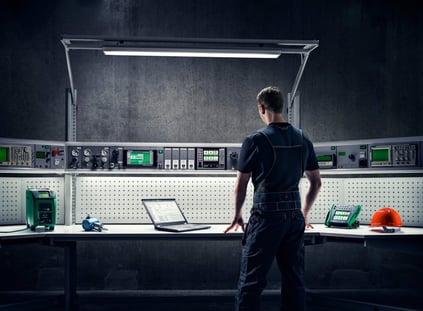This guest post is authored by Heikki Laurila, product manager at Beamex.
In today’s process industry, instruments are often calibrated in the field. Portable calibration solutions are used, but it can be more convenient  and effective to do calibration in a workshop. Selecting between field and workshop calibration is not a black-and-white situation. These two methods are not exclusive alternatives; instead, they complement each other. Let’s discuss some of the most common reasons for establishing a workshop and doing the calibrations, or some of them, with dedicated workshop calibration equipment.
and effective to do calibration in a workshop. Selecting between field and workshop calibration is not a black-and-white situation. These two methods are not exclusive alternatives; instead, they complement each other. Let’s discuss some of the most common reasons for establishing a workshop and doing the calibrations, or some of them, with dedicated workshop calibration equipment.
1) Commissioning
A common reason to calibrate in a workshop is during the commissioning of a new plant, or some new parts of the plant. Typically, during commissioning, instruments have been purchased and are in storage in large quantities, waiting for installation. At that point, it’s very efficient to calibrate all instruments in the workshop before they are taken out into the field and installed. When installing fieldbus, other aspects also need to be taken into account. If the plan is to calibrate fieldbus transmitters and loops in the field by reading the control system readout, one needs to wait until the fieldbus and the process control system are up and running. If the equipment in the workshop is capable of calibrating fieldbus instruments, the fieldbus process instruments can be calibrated in the workshop before they are installed in the field.
2) Total uncertainty of the calibration
The accuracy of field instrumentation is continuously improving, therefore setting higher requirements for calibration equipment and calibration processes. When in the field, the most significant aspects of the total uncertainty often do not come from the calibration equipment but from the calibration processes and the human factors. Calibrating in a workshop can result in a more accurate calibration with less total uncertainty because environmental and operating procedures are better controlled.
3) Primary standards in a workshop
As mentioned in the beginning, workshop calibration and field calibration complement each other. There may be higher-accuracy, non-portable calibration equipment in the workshop as the primary reference calibration equipment. This will save money and time as the calibration equipment doesn’t need to be sent out for periodical recalibrations. Most of the recalibration can be done by oneself and only the primary standards will need to be sent out for recalibration.
4) Spare device calibration / rotating spares
Sometimes it’s more convenient to calibrate a spare device than to replace it. Especially when the calibration is difficult to do in the field, or the calibration takes a very long time to perform. This is also the case when the device has to be sent out to a third party calibration laboratory for calibration. When spare device calibration is performed in-house, it is most effective to perform the calibration in a workshop that has a suitable setup always ready for use. The spare device may also be installed in the process only for the time it takes to calibrate the original instrument.
5) Safety
A professional calibration and service/maintenance bench in a workshop can be equipped with proper safety facilities. This includes items such as: isolation transformer, fault current protection, emergency switch, thermal overload protection, ESD protection, just to mention a few. The same kind of safety mechanisms cannot be easily arranged for work performed out in the field.
6) Accreditation and quality system
At times, it’s necessary or beneficial to apply for an accreditation for the in-house calibration service performed. It is easier to get an accreditation for the calibration work performed in a dedicated workshop than it is for field calibration. Also, the uncertainty of the calibration can be lessened when it is done in the workshop. Even if an accreditation is not necessary, it is easier to build a quality system for calibration work done in the workshop.
7) Field conditions vs. workshop conditions
The field can be a hazardous area, setting requirements for the calibration equipment to be used, and not all equipment is suitable for hazardous areas. For example, a temperature dry block cannot be used in hazardous areas, but it is still needed for temperature sensor calibration. Instead of carrying several items of calibration equipment out to the field, it’s easier to take the small device to be calibrated to the workshop, where all calibration equipment is ready for use. The environmental conditions out in the field can be challenging. Going into the field may require use of protective gear and could require a dedicated training to be completed.
8) Efficiency, ergonomics, ease of use
All equipment is always in place and ready to be used. Connections can be easily made and ready for use. The height of the bench tables can be motor controlled so it is easy to adjust ergonomic height for any work. Panel-mounted automatic or manual pressure generation modules are ready for use, there is no need to use manual pressure hand pumps.
In addition to the above arguments for calibrating in a workshop, some maintenance work cannot be performed out in the field. A dedicated workshop with adequate equipment can make it easy and effective.
About the Author Heikki Laurila has been employed at the Beamex headquarters in Finland for 25 years. He is the product manager for Beamex hardware products.
Heikki Laurila has been employed at the Beamex headquarters in Finland for 25 years. He is the product manager for Beamex hardware products.
Connect with Heikki:![]()



